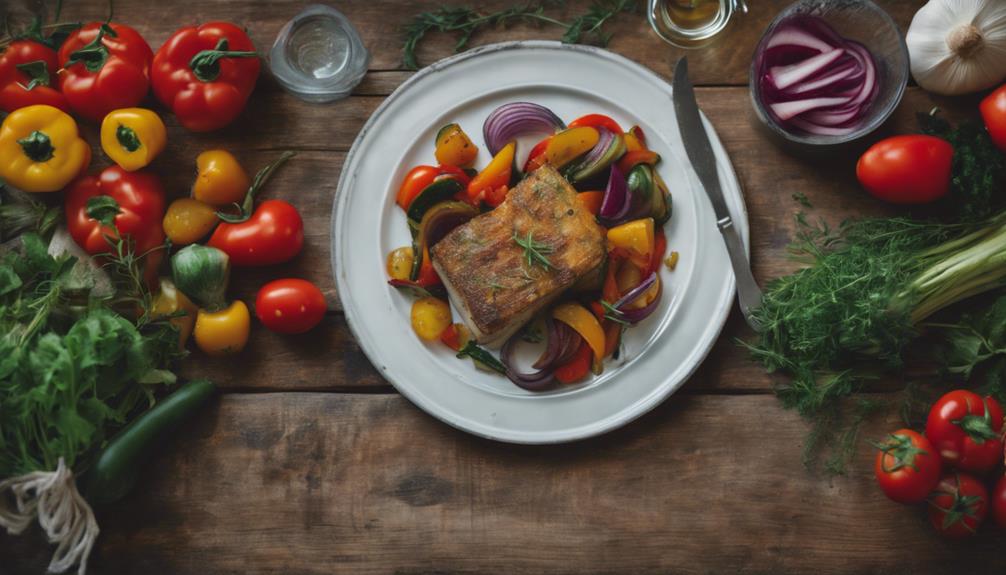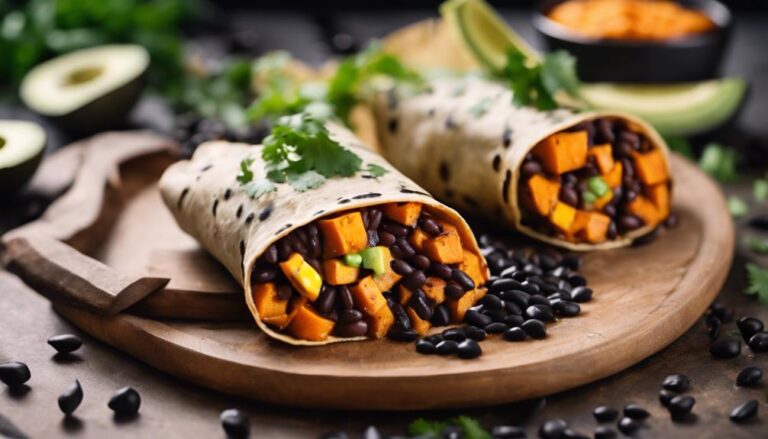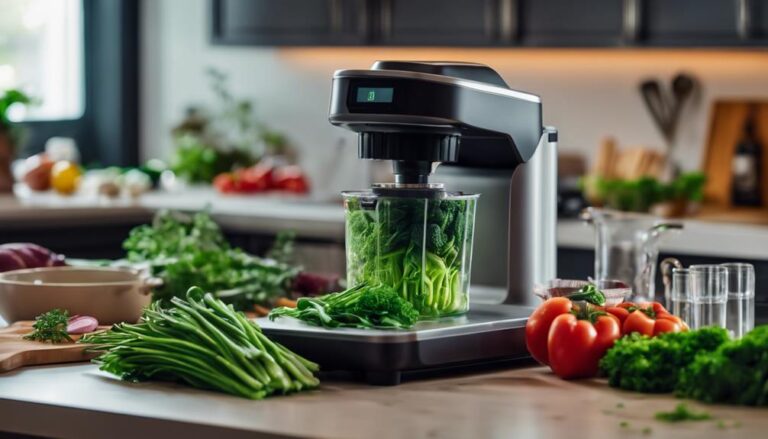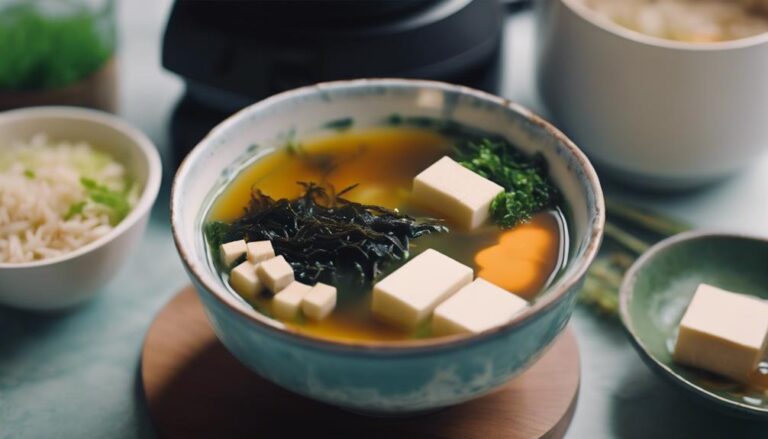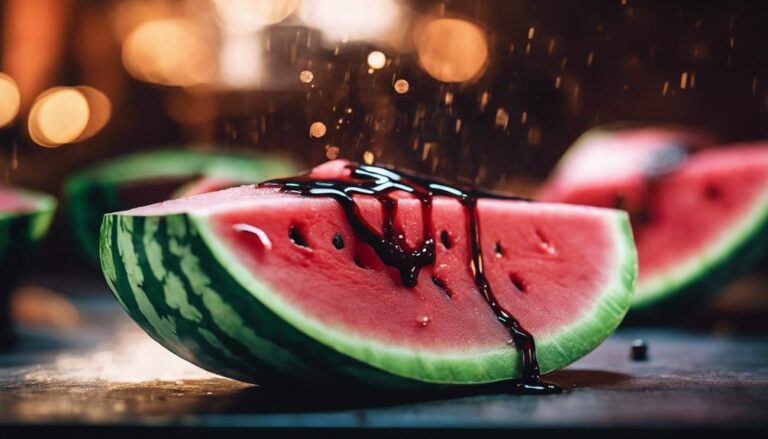Sous Vide Ratatouille for a Rustic French Dinner
Immerse yourself in the essence of French cuisine by preparing a sous vide ratatouille for a rustic French dinner. Elevate traditional vegetables like eggplant, zucchini, and bell peppers using meticulous slicing and seasoning techniques. The sous vide cooking method enhances flavors, textures, and colors, promising a sensory delight. Mastering knife skills for uniform slices guarantees both cooking consistency and visual appeal. Add a unique touch like a puff pastry to elevate the rustic charm of your dish. Discover the art of blending culinary heritage with modern flair for an unforgettable dining experience.
What You Will Learn Here
- Sous vide cooking enhances flavors and textures in ratatouille.
- Incorporate traditional French ingredients like fresh herbs and butter.
- Maintain a rustic charm by adding unique elements like puff pastry.
- Focus on precision and presentation for a sophisticated dining experience.
- Pair with a French wine to elevate the rustic French dinner.
French Culinary Origins
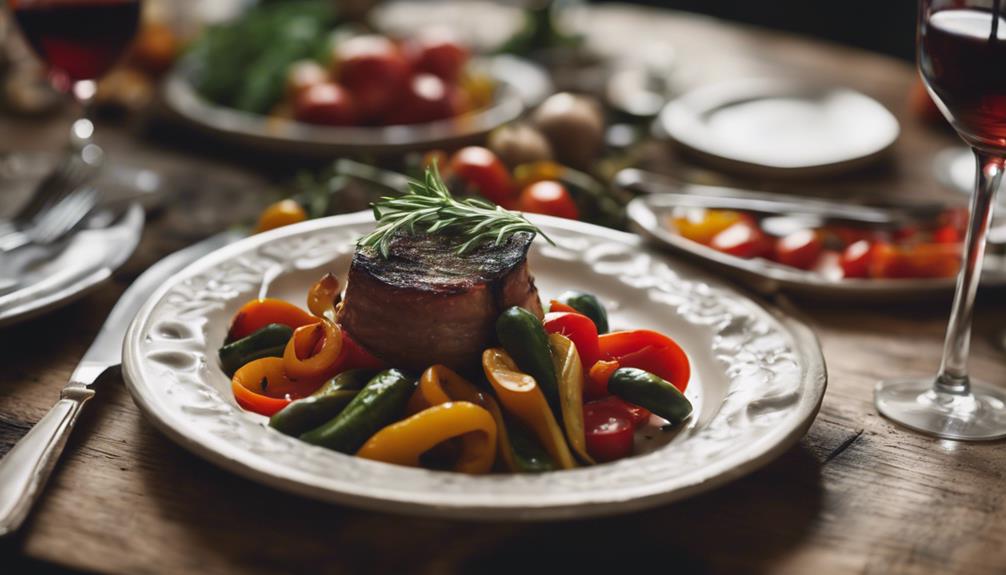
French culinary origins are deeply rooted in a rich tapestry of history and tradition, with influences dating back to the Middle Ages. Traditional French recipes showcase a meticulous approach to cooking, emphasizing the use of fresh herbs, butter, cream, and wine.
Influential French chefs have elevated the art of gastronomy, passing down techniques that continue to shape global culinary standards.
French Culinary History
Rooted in centuries of cultural exchange and historical evolution, the culinary heritage of France epitomizes a fusion of diverse influences that have shaped the country's gastronomic identity. French culinary history traces back to the Middle Ages, where Roman and Moorish cuisines laid the groundwork for what would become the renowned French cooking familiar today. The Renaissance period further refined French culinary techniques, giving rise to iconic dishes like coq au vin and bouillabaisse. The French Revolution marked a pivotal moment, ushering in changes that led to the elevation of haute cuisine. This rich history has resulted in a culinary tapestry defined by regional diversity, with each area contributing unique ingredients and cooking methods to the artistry of French cuisine.
| Influences | Key Periods | Legacy |
|---|---|---|
| Roman & Moorish | Middle Ages | Modern Gastronomy |
| Renaissance refinement | Renaissance | Worldwide Reverence |
| French Revolution changes | French Revolution | Regional Diversity |
Traditional French Recipes
With a culinary legacy shaped by centuries of cultural exchange and historical evolution, the traditional recipes originating from France offer a fascinating insight into the rich tapestry of gastronomic influences that have defined the country's culinary identity.
French cuisine, renowned for its rich history and diverse regional influences, places a strong emphasis on using fresh, seasonal ingredients like vegetables, herbs, and meats to create authentic and flavorful dishes.
Classic French recipes such as Ratatouille exemplify the country's commitment to simple yet sophisticated cooking techniques that elevate the natural flavors of each ingredient.
Drawing inspiration from Mediterranean, Italian, and regional French culinary traditions, these traditional recipes not only showcase the artistry of French cooking but also provide a glimpse into the cultural significance and gastronomic heritage that shape modern French gastronomy.
Influential French Chefs
Embracing the culinary evolution rooted in centuries of cultural exchange and historical refinement, explore the world of influential French chefs whose innovative contributions have shaped the very essence of modern gastronomy. French culinary innovations, modern gastronomic trends, and culinary fusion techniques have been notably influenced by renowned chefs throughout history. Below is a table highlighting some of the most influential figures in French culinary arts:
| Chef | Contribution |
|---|---|
| Catherine de' Medici | Introduced new ingredients and techniques to French cuisine during the Middle Ages. |
| Auguste Escoffier | Revolutionized French cuisine with haute cuisine and modern kitchen organization. |
| Julia Child | Popularized French cooking in the US, introducing techniques and recipes to a wider audience. |
| Paul Bocuse | Reshaped traditional French cooking with emphasis on fresh ingredients and innovative presentations. |
| Alain Ducasse | Showcased modern French culinary techniques globally while respecting tradition. |
Key Ratatouille Vegetables
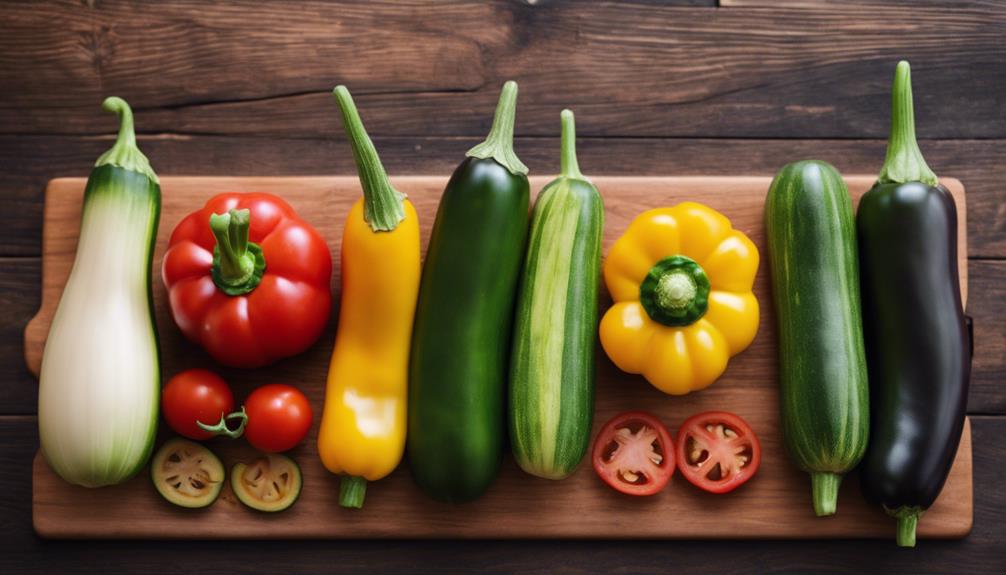
Slicing the key ratatouille vegetables thinly with a mandolin guarantees even cooking and a visually appealing presentation while allowing the flavors to meld seamlessly during sous vide preparation.
To elevate your ratatouille game, consider the following:
- Mandolin Mastery: Achieve uniform slices of eggplant, zucchini, yellow zucchini, and red bell pepper for a consistent texture and cooking time.
- Seasoning Savvy: Enhance the natural flavors of the vegetables by generously seasoning with salt, pepper, and garlic powder.
- Sous Vide Sophistication: Bag the seasoned vegetables and let them cook sous vide at 185°F for 30 minutes to achieve a tender and flavorful result.
- French Fusion: Embrace the colorful medley of vegetables to create a dish that not only tastes divine but also exudes rustic French charm.
Top-rated Ratatouille Variations
When exploring top-rated ratatouille variations, you'll encounter a classic recipe that celebrates the simplicity of fresh vegetables.
Consider a hearty version with eggplant for a more substantial and satisfying dish.
For a taste of the Mediterranean, try a ratatouille enriched with olives, infusing a unique and tangy flavor profile.
Classic Ratatouille Recipe
In the world of top-rated ratatouille variations, the classic ratatouille recipe stands as an epitome of French culinary excellence, showcasing a delightful harmony of eggplant, zucchini, yellow zucchini, and red bell pepper meticulously prepared to perfection.
- Mandolin Magic: Thinly sliced vegetables for impeccable presentation.
- Seasoning Symphony: Salt, pepper, and garlic powder elevate flavors.
- Sous Vide Superiority: Cooking at 185°F for 30 minutes guarantees tender veggies with retained nutrients.
- Sauce Perfection: Blended vegetable trimmings, shallots, garlic, bell pepper, tomato sauce, and seasonings create a flavorful base.
This classic recipe not only highlights the beauty of ratatouille presentation but also masterfully combines vegetable seasoning and sous vide benefits to achieve a dish that truly embodies the essence of French cuisine.
Hearty Ratatouille With Eggplant
For a truly indulgent culinary experience, explore the rich and comforting world of hearty ratatouille with eggplant, a top-rated variation that promises a symphony of flavors and textures.
- Eggplant pairing: The meaty texture of eggplant adds depth and richness to the dish, elevating its overall profile.
- Sous vide benefits: Cooking eggplant sous vide retains its natural juices and flavors, resulting in a tender and flavorful addition to the ratatouille.
- Flavorful textures: The harmonious blend of eggplant, zucchini, and other vegetables creates a dish bursting with diverse flavors and textures.
- Versatile dish: Hearty ratatouille with eggplant isn't only comforting and satisfying on its own but also serves as a versatile side dish that complements a variety of meals.
Mediterranean-Inspired Ratatouille With Olives
Enhance your culinary repertoire with a Mediterranean-inspired twist by integrating olives into your ratatouille, elevating its flavor profile with a delightful touch of brininess and savory richness.
- Olive Pairing: Choose olives like Kalamata or Castelvetrano for varied textures.
- Flavor Experimentation: Balance saltiness with vegetable sweetness and ratatouille richness.
- Texture Contrast: Slice and pit olives before adding them for easier eating.
- Customization: Experiment with different olive varieties and amounts to create a unique, flavorful ratatouille.
Ratatouille Slicing Technique
When slicing vegetables for ratatouille, be mindful of your knife grip to guarantee control and safety throughout the process.
Achieving uniform slice thickness is key for even cooking, enhancing the overall texture and flavor of your dish.
Balancing speed and precision while slicing will result in consistent, professional-looking cuts that elevate the visual appeal of your ratatouille.
Knife Grip Importance
Securing your grip on the knife while using a mandolin for slicing vegetables is a vital aspect of mastering the art of ratatouille preparation. Knife safety and technique are essential for precision slicing and control.
A firm grip guarantees efficient cutting and consistency in the thickness of the vegetable slices. By holding the knife securely, you reduce the risk of accidental cuts and enhance overall kitchen safety.
Mastering the knife grip technique not only safeguards against injuries but also leads to uniform and professional-looking vegetable slices, elevating the visual appeal of dishes like ratatouille.
Uniform Slice Thickness
Achieving uniform slice thickness with a mandolin in ratatouille preparation is a fundamental skill that guarantees both impeccable cooking consistency and visual appeal. The mandolin's benefits lie in its precise slicing technique, allowing for consistent cuts that enhance the vegetable texture in the dish.
By maintaining a thickness of around 1/8 inch, the vegetables cook evenly, ensuring a harmonious blend of flavors and textures. These consistent slices not only contribute to the overall mouthfeel of the ratatouille but also elevate its presentation, adding a touch of sophistication and visual appeal to the final dish.
Mastering the mandolin technique is essential for creating a visually stunning and delicious ratatouille that will impress even the most discerning diners.
Speed Vs Precision
To optimize your ratatouille slicing technique, striking a balance between speed and precision is essential for efficiently crafting uniform vegetable slices. The efficiency dilemma arises when deciding between quick cuts for time management and ensuring culinary aesthetics with consistent results.
Embracing the precision balance allows you to achieve the desired thickness for each vegetable, promoting even cooking and enhancing the visual appeal of your dish. By mastering the art of swift yet accurate slicing, you can streamline the preparation process without compromising on the quality of your ratatouille.
Utilizing a mandolin with various thickness options provides customization while maintaining efficiency. Remember, implementing proper safety measures, such as using a guard or wire mesh glove, is vital when working swiftly with the mandolin to achieve a harmonious blend of speed and precision.
Final Thoughts
For a culinary adventure that goes beyond the ordinary, explore the world of sous vide ratatouille and uncover a symphony of flavors and textures that elevate this classic dish to new heights. Reflections on the culinary techniques employed reveal the meticulous preparation and cooking methods involved in achieving a perfect balance of flavors in each vegetable.
The presentation styles investigated in this journey showcase the artistry of mandolin-sliced vegetables intertwined with a rich, homemade sauce, culminating in a dish that not only delights the taste buds but also pleases the eye.
As you immerse yourself in the final thoughts on this gastronomic experience, consider the addition of unique elements like puff pastry to elevate the rustic charm of ratatouille to a new level of sophistication. Pairing this vegetable medley with a succulent Wagyu Tomahawk steak further enhances the dining experience, creating a harmonious balance of textures and flavors on your plate.
Embrace the innovation and precision of sous vide cooking to craft a memorable dining affair that will leave a lasting impression on your guests.
Frequently Asked Questions
What Is the Secret for a Good Ratatouille?
To create a stellar ratatouille, the secret lies in mastering the art of seasoning vegetables. Enhance flavors by using fresh, high-quality ingredients. Elevate the dish by crafting a rich sauce and layering it meticulously. Adjust seasonings to taste for a perfect flavor profile.
Can Ratatouille Be Prepared Ahead of Time?
When preparing ratatouille, you can maximize flavor by making it ahead. Sous vide offers precise cooking and enhanced taste. Utilize meal prep strategies to save time and savor the rich, developed flavors of ratatouille for a delightful dining experience.
What Are the Two Ways Ratatouille Is Commonly Served?
Two common ways ratatouille is served are as a rustic stew with vegetables cooked together and elegantly plated with sliced vegetables. The traditional stew offers comfort, while the modern presentation impresses for special occasions, showcasing seasonal ingredients beautifully.
What Is a Peasant Dish Ratatouille?
In a traditional Provencal setting, ratatouille embodies the essence of a peasant dish with its humble ingredients like eggplant, zucchini, and bell peppers. It reflects a frugal approach to cooking, showcasing the simplicity and richness of Provencal flavors.
Conclusion
Overall, creating a sous vide ratatouille for a rustic French dinner is a culinary experience that combines tradition and innovation.
By carefully selecting the key vegetables, mastering the slicing technique, and exploring various flavor variations, you can elevate this classic dish to new heights.
The sous vide method guarantees that each ingredient retains its natural flavors and textures, resulting in a harmonious and delicious final product that's sure to impress even the most discerning palates.
Bon appétit!
